Please note that the island is only open to tourists during the months of March to November and during daylight hours only.
More information can be found in the link provided at the bottom of this cache listing under the section "Logging Requirements."

Unique Feature of Guishan Island — An Active Stratovolcano:
Guishan Island was formed because of volcanic activity. The island is the top of an andesite stratovolcano. An andesite stratovolcano is a tall, conical volcano composed of one layer of hardened lava, volcanic ash and tephra, which are rock fragments and particles ejected by a volcanic eruption. These volcanoes are characterized by a steep profile and periodic, explosive eruptions. The lava that flows from them is highly viscous, or very thick, and cools and hardens before spreading very far, which rises from the seafloor. This andesite stratovolcano is the only active volcano in Taiwan, displaying active fumaroles and solfataras. A fumaroles are an opening in or near a volcano, through which hot sulphurous gases emerge, and solfataras are volcanic craters emitting sulphurous and other gases. Guishan Island has an area of 2.841 square kilometers (1.097 sq mi), and the highest point reaches 401 m (1,316 ft) above sea level. Below is diagram of the characteristics of a stratovolcano:

Another Unique Feature of Guishan Island — Hydrothermal Vents:
In addition to Guishan Island being an active volcano, the surrounding sea is home to hydrothermal vents! That's right! These are basically hot springs on the ocean floor. And these particular kinds of "sea springs" were just discovered quite recently (1977). So Guishan Island is a two-for-one deal! You get an active volcano and active ocean hot springs all in once place! Hydrothermal vents are the result of seawater percolating, or filtering gradually through a porous surface, down through fissures in the ocean crust. Fissures are long, narrow openings or lines of breakage made by cracking or splitting. These fissures are in the vicinity of spreading centers or subduction zones (places on Earth where two tectonic plates move away or towards one another). The cold seawater is heated by hot magma and reemerges to form the vents. Seawater in hydrothermal vents may reach temperatures of over 700° Fahrenheit or nearly 400° Celcius. Below is a digram of how hydrothermal vents are formed:

Now because these submarine hot springs are constantly emitting chemicals up to the surface, they can be characterized by different physical and chemical factors, including the minerals, temperatures, and flow levels of their plumes, or long clouds of smoke or vapour. The first cateogorization of hydrothermal vents are known as Black Smokers. These emit the hottest, darkest plumes, which are high in sulfur content and form chimneys up to 18 stories tall, or 55 meters (180 feet). The other cateogorization of hydrothermal vents are called white smokers and their plumes are lightly colored and rich in barium, calcium, and silicon. Compared to black smokers, white smokers usually emit cooler plumes and form smaller chimneys. Vents with even cooler, weaker flows are often called seeps. They appear to shimmer because of differences in water temperatures or bubble because of the presence of gases, like carbon dioxide. Black and white smokers can coexist in one hydrothermal vent ecosystem. Below is a digram of the different chemicals that may be present in black and/or white smokers:

Logging Requirements:
In order to log a Found It! for this Earth Cache, please go to the posted coordinates and Referenced Waypoint (WP 1) to complete the following tasks:
Please note that in order to get to the island you need to apply for permission and pay fees (approximately NTD $1,600) in advance with a licensed tour operator like this one here or here (both in Chinese). There are lots of them around so simply Googling "Tours to Guishan Island" or similar keywords will help you find one. Remember that when you apply to visit Guishan Island you must tick the box for 401 Highland (401高地) in order to get permission to hike to the top of Guishan Island, otherwise you will only be allowed to wander the island on "level ground" and and thus unable to visit the mountain peak on the island to complete this Earth Geocache. One last thing, don't worry about how to get to Waypoint 1 as all tours to the island will first make a loop around the island. This way you will be able to easily complete the tasks for Waypoint 1.
1. As you approach Guishan Island and as you make your loop around the island, observe the features of the island. Based on your understanding of stratovolcanoes, what features indicate that Guishan Island is an active stratovolcano?
2. Also as you are looping around the island, carefully observe the sea at the Referenced Waypoint (WP 1). Based on your understanding of hydrothermal vents, what features are present here that indicate the existence of active hydrothermal vents? Please note the size, color, odor, and chemicals you observe at this area.
3. Based on your understanding of Black and White Smokers, and based on your observations of the area where hydrothermal vents are located there at the Referenced Waypoint (WP 1), what type of hydrothermal vent would you say is present at this location. How did you come to your conclusion?
Now hike to the top of the island (Posted Coordinates) to make further observations about this stratovolcano and hydrothermal vents.
4. At the top of mountain here, (Posted Coordinates), observe the area where you saw the hydrothermal vents earlier. Based on what you observed earlier at the Referenced Waypoint (WP 1), what changes, if any, in color, size, odor, and chemicals present took place during the time you first observed? Based on your understanding of hydrothermal vents, what might constitute a change?
5. Also at the Posted Coordinates, what other features are present that indicate Guishan Island is an active stratovolcano?
6. (Optional) Take a picture of yourself somewhere around the island or on the boat. (You don't have to show your face of course.)
You may log a Found It! on this cache after you have completed the tasks and emailed me the answers. If there are any issues with your answers, I will contact you. Thank you for visiting this Earth Cache. I hope you enjoy your time on Guishan Island!